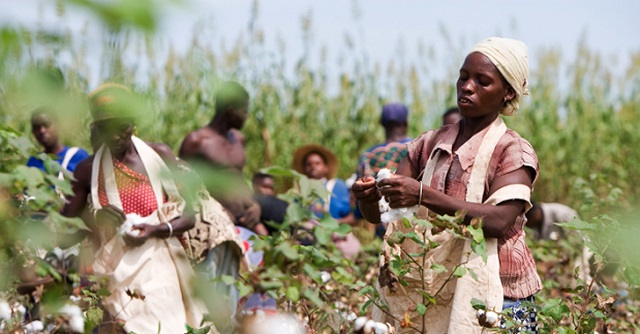
Lamwo, Uganda | THE INDEPENDENT | Cotton experts are predicting the favourable weather conditions in the Acholi sub region could see a higher production of cotton lint this farming season.
Heavy rainfalls that triggered flooding last year affected cotton production in the region, leaving thousands of farmers with heavy losses. The region produced only about 40,000 bales of cotton lint according to statistics from Uganda Cotton Ginners and Exporters Association.
Douglas Bhosopo, the seeds inspector at Uganda Cotton Ginners and Exporters Association says that for the past two years [2019-2020], cotton production in the region has declined due to heavy rains. He says the rains affected the flowering of cotton as well as the spraying of chemicals against pests in Agago, Lamwo, Gulu, and Kitgum districts.
Bhosopo notes that despite a period of drought experienced between May and June this year, during the planting season, it had a limited effect on cotton crops and believes farmers will this time around have a high yield.
Bhosopo anticipates that once harvest commences by November, the region may see the production of close to 51,000 bales of cotton lint. He says although the figures are lower than productions between 2012, 2013, and 2014, it’s promising because the region is now coming back to its glory days of cotton production.
There were around 78,000 cotton farmers in Acholi sub-region alone in the past. Bhosopo however says the numbers have since decreased to around 35,000 but maintains that the current numbers are of farmers who are seriously engaged in cotton farming ventures.
He acknowledges that crops such as sim sim, especially in East Acholi where their productions are high had taken over the cultivation of cotton due to the lucrative market and high prices they fetch.
To woo the farmers into cotton production, the Cotton Development Organization, a body that monitors the production, processing, and marketing of cotton has set shillings 2,000 as an indicative price of cotton this farming season.
Bhosopo says the starting price which had in the past been much lower is expected to encourage farmers to use the remaining planting season of September to boost cotton production.
Tiberio Oyul, a cotton farmer in Orom East sub county says that he is hopeful of getting a good harvest this farming season after planting cotton on a five acres piece of land.
Oyul says unlike last year when he only earned 1.1 Million Shillings due to bad weather and poor seeds, there is hope that his earnings may double.
“The weather wasn’t well last year, equally the cotton seeds we received from one of the organizations that supported farmers in our area didn’t germinate well. As a farmer, last year was a failed season and I’m hopeful for this farming season,” said Oyul.
Kenneth Nyero Nyokcek, LCIII chairperson Namokora town council says this year’s weather is promising and has seen the resumption of cotton farming in his area, unlike in the past. He however says farmers are worried about the ever-fluctuating prices of cotton every year, a reason he says many have been shifting to food crop growing especially sim sim.
About 600 metric tons of cotton seeds have so far been distributed to farmers in Acholi sub-region this farming season according to reports from the Uganda Cotton Ginners and Exporters Association. Cotton remains one of Uganda’s third-largest export crops after coffee and tea and is the main source of income for some 250,000 households, according to information from Uganda Cotton Development Organization.
The seasonal rainfall outlook released by the Uganda Meteorological Authority this month shows that the rainfall currently being experienced in the Eastern Northern parts of Uganda comprising Kitgum, Lamwo, Agago, and Pader districts is expected to continue until September with relaxation likely to set in October.
Meanwhile, in Central Northern parts comprising Gulu, Omoro, Nwoya, and Amuru districts, rainfall is expected to continue until the end of September with slight relaxation during October. Cessation of rainfall is expected around early to mid-November.
*****
URN
 The Independent Uganda: You get the Truth we Pay the Price
The Independent Uganda: You get the Truth we Pay the Price



